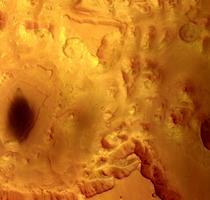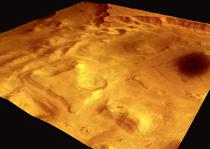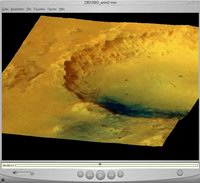Navigation/Menü: Links auf weitere Seiten dieser Website und Banner
23.01.2004
HRSC Press Release #005 - Dark Spot (orbit 0018)
 RGB Colour Image #1 |
Die Farbansichten wurden aus dem senkrecht blickenden Nadirkanal und den Farbkanälen erstellt, die Schrägansicht wurde aus den Stereokanälen der HRSC berechnet. Die Anaglyphen werden aus dem Nadirkanal und einem Stereokanal abgeleitet. Die schwarzweißen Detailaufnahmen wurden dem Nadirkanal entnommen, der von allen Kanälen die höchste Auflösung zur Verfügung stellt.
The colour scenes have been derived from the three HRSC-colour channels and the nadir channel. The
perspective views have been calculated from the digital terrain model derived from the
stereo channels. The anaglyph image was calculated from the nadir and one stereo channel.
The black and white high resolution images were derived form the nadir channel which provides the
highest detail of all channels.
 Perspective view #1 |
 Movie #1 (36 MBs) |
Download
hochaufgelöste Bilddaten / high resolution image data
| RGB Colour Image #1: |
| Perspective view #1: |
| Movie #1: |
© Copyright: ESA/DLR/FU Berlin (G. Neukum)

 Deutsch
Deutsch

